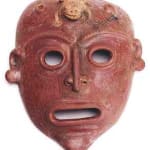Terracotta Mask, 300 BCE - 300 CE
Terracotta
17
PF.4253
This beautiful mask was most probably used to cover the face of the dead. The entire surface is covered with intricate tribal designs. There are large rounded holes for where...
This beautiful mask was most probably used to cover the face of the dead. The entire surface is covered with intricate tribal designs. There are large rounded holes for where the eyes and mouth should be. The nose is very stylized and it has sharp grooves that form the nostrils. The chin comes to a very fine point and the earlobes are enlarged. The eyebrows stretch across the entirety of the face and have serrated grooves through them. The most prominent characteristic of the mask is the frog that is perched upon the forehead. The frog is extremely realistic and is not painted. This gives it sharp contrast to the red burnished color of the mask and creates the image that the frog is about to leap. This emblem signifies the person the mask is placed over. Sometimes the shaman is associated with this creature. It was said that crushed up frog skin once snorted caused one to hallucinate.



